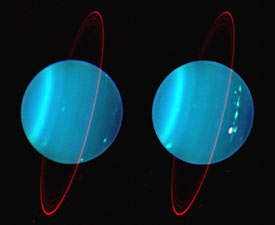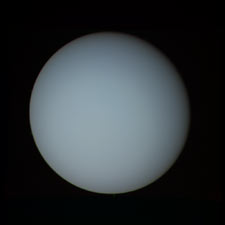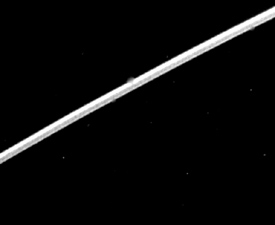
These two images of Uranus, each taken at Keck Observatory in Hawaii, show a near-infrared view of the planet and its clouds. Blue, green, and red represent 1.26, 1.62, and 2.1 microns respectively. The planet's North Pole is at 4 o'clock.
Courtesy Lawrence Sromovsky (University of Wisconsin-Madison) and W. M. Keck Observatory.
If you had to vote for the most boring planet, you might pick Uranus. Unenhanced Voyager 2 images from its 1986 flyby revealed a bland, monochromatic, turquoise countenance with few clouds or belts. But recent near-infrared images from the 10-meter Keck II telescope in Hawaii demonstrate the old maxim that first impressions can be deceiving.
The images, taken in 2003 and 2004 with adaptive optics to counter atmospheric blurring, revealed dozens of discrete clouds, which is more than the total seen in all previous observations combined up to the year 2000. The clouds vary in size, brightness, and longevity, proving that Uranus has a dynamic and complex atmosphere after all.
In the northern hemisphere, the largest group of atmospheric features ever observed on Uranus — a narrow, 29,000-kilometer-long (18,000 miles) cloud complex — disappeared in only one month. Teams led by Lawrence A. Sromovsky (University of Wisconsin) and Heidi B. Hammel (Space Science Institute) have documented wind speeds exceeding 225 meters per second (about 500 miles per hour) — the fastest yet recorded on Uranus. "Records are breaking as fast as we can take the data," says Hammel.

The Voyager 2 spacecraft captured this somewhat bland image of the planet Uranus. Closer inspection by ground-based telescopes and the Hubble Space Telescope revealed a far more interesting atmosphere than Voyager suggested.
Courtesy NASA/Jet Propulsion Laboratory.
But not all clouds are transient. By combining Keck and Hubble Space Telescope images, Kathy Rages (SETI Institute) has identified one gigantic storm system that has lasted at least five years. Sromovsky and his University of Wisconsin colleague Patrick M. Fry suggest this storm may even have persisted since the Voyager flyby 18 years ago. The feature drifts north and south across 5° of latitude. "Some discrete features change dramatically in one to two hours, but others last for at least a month, and one for probably 18 years or more," says Sromovsky.
Using Keck, Hammel's group observed this storm system at much higher altitudes than ever seen before. The storm brightened on July 4, 2004, leading the team to label it "the Fourth of July fireworks." In all likelihood, vigorous convection raised material from deep down.
The major reason for Uranus's newfound dynamism is probably its bizarre seasonal cycle. Uranus is the solar system's only planet whose rotation axis is tipped over nearly in its orbital plane — its orbital tilt is a whopping 98°. When Voyager 2 flew by in 1986, Uranus's southern hemisphere was in early summer and was thus constantly bathed in sunlight. Now, the southern summer is nearing an end, meaning the hemisphere is experiencing increasing darkness as the 2007 equinox approaches. The northern hemisphere is seeing increased sunlight on a daily basis.

New research suggests that Uranus's rings, like the Epsilon Ring shown above, are likely to be single sheets of particles.
Courtesy NASA/Jet Propulsion Laboratory.
Thanks in part to the power of adaptive optics, the Keck images also allowed Imke de Pater (University of California, Berkeley) and her colleagues to recover Uranus's innermost ring, known as 1986U2R. This feature had only been seen previously in one Voyager 2 image. The ring is 1,000 times dimmer than the planet's brightest ring, the outermost Epsilon Ring. De Pater's analysis of the Keck data indicates that unlike the rings of the other large planets, Uranus's rings are most likely monolayers — comprised of single sheets of particles.
Amateur astronomers are also recording seasonal effects on Uranus. Photoelectric photometry by Richard W. Schmude, Executive Director of the Association of Lunar and Planetary Observers (ALPO), and other ALPO members, show that Uranus has dimmed by 6 to 8 percent since 1991, part of which stems from the fact that Uranus's disk is slightly oblate, and is getting smaller because of its changing orientation with respect to Earth. Professional astronomer Wes Lockwood (Lowell Observatory) has reached similar conclusions using data over longer timespans. Hammel urges amateurs to look for discrete cloud features on Uranus, and to contact ALPO if they see anything unusual.
The teams reported their results last week at the American Astronomical Society's Division of Planetary Sciences conference in Louisville, Kentucky.
 0
0
Comments
You must be logged in to post a comment.